
Top 8 DIY Rose Face Masks: Recipes, Benefits, and Tips
- May 06, 2025
- by
- Shanaya
A rose face mask is simple but effective method of naturally hydrating, calming, and refreshing your skin.
A fresh mask rose provides antioxidant nourishment, restoring tired skin, whereas a retexturizing mask with rose smooths and refines your complexion.
Want to take your skincare routine to the next level? Learn these 8 DIY rose face masks for radiant glow and glass skin!
Content
In this article, you’ll find:
- Key skin benefits of roses
- Eight DIY rose face mask recipes with simple kitchen ingredients
- Safety tips to ensure a gentle, irritation-free experience
- Why DIY beats commercial the advantages of crafting your own masks
Natural rose face mask: glow, hydrate & refresh
Why roses are great for your skin
Roses have been cherished in skincare for centuries, offering a natural touch to beauty rituals.
They aren’t just beautiful but also contain skin-loving properties.
Below are proven amazing benefits of rose face masks.
1. Moisture booster & skin protection
Rose water helps lock in moisture without clogging pores, thanks to its natural humectant properties.
A 2022 review noted that humectants in natural extracts like rose water can hydrate the skin by drawing moisture from the environment into the skin’s surface.
2. Soothing & anti-inflammation
Phytonutrients in rose petals calm redness and irritation. These properties make mask roses ideal for sensitive or acne-prone skin.
3. Antioxidant & anti-aging
Rich in vitamins A and C, rose extracts help rebuild collagen. Also, they combat free radicals and fade fine lines.
In 2024, International Journal of Research and Review confirmed that Rosa damascena (also known as Bulgarian rose) extracts neutralize free radicals. Thus, the properties protect skin cells from oxidative stress.
Besides, rosehip extracts improve skin elasticity and reduced wrinkles.
4. Toning & refining
A mild astringent effect tightens pores, smooths texture, and balances oil production.
A 2023 study noted that Rosa damascena extracts reduced sebum (oil) production in oily skin models. (Source)
 5. Aromatherapy effect
5. Aromatherapy effect
The gentle scent of roses turns your skincare routine into a relaxing, spa-like ritual.
A review of 72 trials and clinical studies in 2023 reported that inhaling rose oil reduced stress and anxiety by lowering cortisol levels. The result show 70% of positive effect.
Summary
Roses hydrate, soothe, protect, refine, and enhance relaxation in skincare.
Top 8 easy DIY rose face mask recipes
1. Rose clay mask
Clay deeply cleanses, removes excess oil. It also contains minerals like silica and magnesium.
Silica improves skin elasticity, while magnesium soothes and nourishes. Rose water adds moisture, softens, and calms the skin.
So, clay and dried rose petal mask relaxes the skin, improves hydration, and cleanses deeply.

How to make rose clay mask
Ingredients
- 1 tbsp of pink kaolin clay (or bentonite)
- 1–2 tsp of rose water
- 1 tsp of honey or plain yogurt
- Optional: 1–2 drops jojoba or almond oil
Instructions
- In a clean bowl, mix clay and rose water until a smooth paste.
- Stir in honey (or yogurt) and oil (if using).
- Apply evenly to clean skin. But avoid the eye area.
- Leave for 10–15 minutes.
- Rinse face with lukewarm water.
- Gently massage to exfoliate, then pat dry.
Approach 2
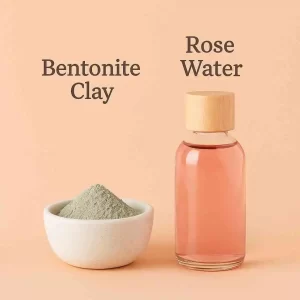 You can also make simpler mask rose with 2-ingredient recipe.
You can also make simpler mask rose with 2-ingredient recipe.
- Mix bentonite and rose water at rate 1:1
- Apply the paste to face for 15 minutes.
- Rinse with warm water.
Usage tip
-
- Best for normal, oily, and combination skin.
- Apply 2–3 times weekly for oily or combination skin.
- For dry and sensitive skin, limit use to once a week and monitor skin’s response.
2.Rose jelly peel-off mask
A rose jelly peel-off mask exfoliates, moisturizes, and calms the skin.
This retexturizing mask also reduces pores, boosts radiance, and provides antioxidant benefits.
So, fresh rose mask makes skin smooth and refreshed.
Steps to prepare a rose jelly peel-off mask
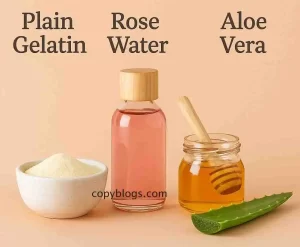 All you need
All you need
- 1 tbsp of plain gelatin (or agar powder)
- 2–3 tbsp of warm rose water
- 1 tsp of honey or glycerin
- 1 tsp of aloe vera gel (optional)
Steps
- Warm rose water to ~100°F (38°C).
- Whisk in gelatin until fully dissolved.
- Stir in honey and aloe vera. Let thicken for a minute.
- Apply a thin layer to clean skin.
- Leave on 15–20 minutes until firm.
- Peel off gently and rinse any leftover residue.
Notes
-
- Best for all skin types, including sensitive and mature skin.
- Use once a week to avoid over-exfoliation.
- Gelatin can adhere strongly to facial hair and delicate skin.
- Hence, avoid eyebrows and hairline during application.
3. Aloe vera gel and rose water mask
An aloe vera gel and rose water face mask hydrates and calms irritation.
Rose water face mask also reduces inflammation, heals skin and enhances its natural glow.
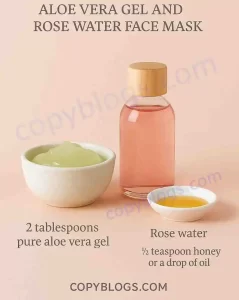 How to make aloe vera gel and rose water face mask
How to make aloe vera gel and rose water face mask
Ingredients
- 2 tbsp of pure aloe vera gel
- 2 tbsp of rose water
- Optional ½ tsp of honey or a drop of oil
Instructions
- Mix aloe vera and rose water until smooth.
- Apply evenly to face and neck. Avoid eye area.
- Leave it on 10–15 minutes.
- Rinse your face, then massage excess into skin.
Usage tip
-
- Best for: all skin types.
- Can be used daily as a hydrating treatment or toner.
- If using as a toner, apply with cotton pads. Let it absorb into the skin.
4. Rose powder face pack
A rose powder face pack brightens the skin, controls oil and soothes irritation. This retexturizing mask exfoliates for smoother and healthier skin.
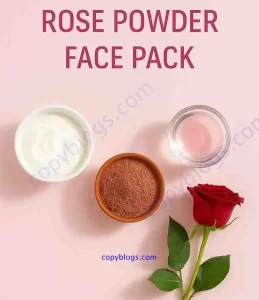 How to make DIY rose powder face pack
How to make DIY rose powder face pack
What you need
- 2 tbsp of dried rose petal powder
- 1 tbsp of plain yogurt (or aloe vera gel)
- Splash of rose water
Steps
- Mix rose powder and yogurt into a creamy paste. Add rose water if needed.
- Apply to face and neck for 15–20 minutes.
- Rinse with cool water.
- Gently scrub to exfoliate.
Usage tip
-
- Suitable for all skin types.
- Apply 1–2 times per week.
- If you have sensitive skin, swap yogurt for aloe vera gel to avoid irritation.
5. Rose and milk mask for brighter skin
Roses packs with vitamins E, D, and C. Those vitamins brightens skin, reduces dark spots. They also combat aging and soothes inflammation.
Lactic acid in unsweetened milk cleanses, hydrates, and supports anti-aging benefits.
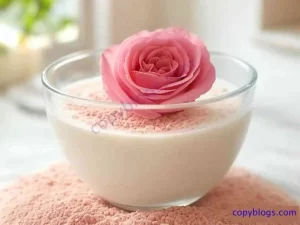 How to make rose and milk mask
How to make rose and milk mask
What you need
- 2 tbsp of rose powder
- 5-6 tbsp unsweetened milk
Method
- Mix all ingredients until a smooth paste.
- Apply to face, gently massage for 20 minutes.
- Rinse with cool water.
Tip
- Best for sensitive and dry skin.
- Use this mask rose 2-3 times a week.
6. Rose and honey mask
Honey’s antibacterial and healing properties fight acne and hydrate. Vitamin C-rich rose petals smooth, brighten, and enhance skin elasticity.
Regular use of fresh rose mask restores a healthy glow.
 Ingredients
Ingredients
- 8 rose petals
- ½ tsp lemon juice
- 2 tsp pure honey (prefer organic)
Instructions
- Soak rose petals in diluted saltwater for 15 minutes to remove dirt.
- Crush petals, then mix with lemon juice and honey.
- Apply to face evenly, gently massage.
- Leave for 15-20 minutes.
- Rinse your face with water.
Usage tip
-
- Best for all skin types, especially dry and mature.
- Avoid lemon juice if sensitive.
- Never apply to open wounds or irritated skin.
7. Rose and turmeric mask
The mask combats flare-ups and fades dark spots. Plus it soothes, cleanses, and reduces inflammation.
Regular use brightens and balances skin moisture.
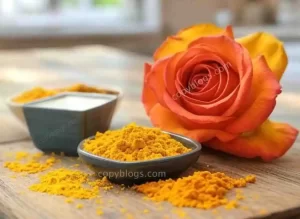 How to make rose and turmeric mask
How to make rose and turmeric mask
You’ll need
- 5 rose petals
- 2 tbsp of turmeric powder
- 2-3 tbsp of unsweetened milk
Steps
- Wash, soak, and crush rose petals.
- Mix with milk and turmeric.
- Apply a thin layer, massage for 3-5 minutes.
- Let it sit for 15-20 minutes. Then, rinse with water.
- Follow up with your skincare routine.
Usage tip
-
- Best for all skin types.
- Apply 1–2 times a week.
- Turmeric may stain and cause allergies to some individuals.
8. Rose collagen mask
The rose face mask blends gelatin and fresh petals to reduce wrinkles and enhance elasticity.
It also prevents acne, soothes inflammation and brightens skin.
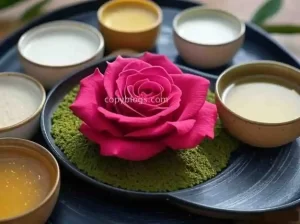 How to Make Rose Collagen Mask
How to Make Rose Collagen Mask
Require
- 3 fresh rose petals
- ½ tsp green tea powder (or content of 1 used tea bag)
- 1 tbsp gelatin powder (or 1 gelatin sheet)
- 50 ml unsweetened milk
- 100 ml hot water ~100°F (38°C)
Instructions
- Wash, then crush rose petals.
- Mix well green tea powder and crushed petals.
- Add water, steep for 2 minutes.
- Stir in gelatin powder until blended.
- Mix milk, and let cool slightly.
- Apply evenly on face. Stay relaxed for 15–20 minutes.
- Peel off or rinse with lukewarm water.
Tip
-
- Best for all skin types, particularly dry and mature.
- Apply this mask rose 1 – 2 times weekly.
Summary
-
- Rose face masks hydrate, brighten, and soothe the skin.
- Patch-test before use to avoid irritation.
Satefy guidelines
Natural rose face mask requires patience and proper care to achieve the best results.
1. Allergy test
- Apply small amount on the inner wrist or behind the ear. Wait 24 hours and check for irritation.
- Individuals with sensitive skin or allergies should consult a dermatologist before use.
2. Preparation
- Mix enough amount for a single application to avoid waste.
- Masks are most effective when freshly made.
3. Before Use
- Cleanse the skin thoroughly to remove dirt and oils.
4. Application
- Avoid the eye area, hairline, and irritated skin.
- If discomfort occurs, rinse off immediately.
5. Aftercare
- Rinse with lukewarm water and pat dry.
- Provide moisturizer to skin.
- Apply sunscreen 15 minutes before sun exposure or screen time to prevent light sensitivity.
6. Storage
- Store extra mask mixture in an airtight container and refrigerate.
- Use within 24 hours for best results. Else, freeze and use within 7 days.
- Add a few drops of rose water to rehydrate dried clay masks before use.
- Avoid masks exposed to contaminants or left uncovered.
- Discard if texture, smell, or consistency changes.
7. Consistency
- Avoid overuse to prevent irritation.
- Natural ingredients take time to show results.
- Follow recommended frequency to maintain balance.
Summary
Stick to safety tips with patch test, sunscreen and proper storage for best results.
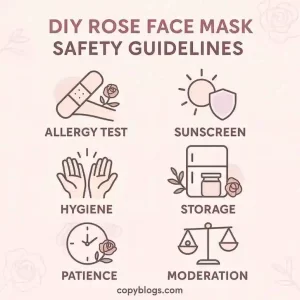
DIY rose face mask vs. store-bought: Benefits of going homemade
Why DIY is the better choice
1. Ingredient control
- Use your favorite natural contents.
- No hidden preservatives, synthetic fragrances, or irritants.
2. Cost-effective & eco-friendly
- Less packaging, biodegradable ingredients, and smaller batch sizes.
3. Customizable
Modify ingredient amount as per specific need. For example, add more honey for moisture or reduce clay if dry skin.
Summary
DIY rose retexturizing mask are pure, affordable, eco-friendly and free from synthetic additives.

Conclusion
A DIY rose face mask is a gentle but powerful approach. The face pack provides deep hydration, brightening, and rejuvenation.
Whether you go with rose petal or rose powder face pack, all pamper your skin.
For best results, always follow safety tips. If you have any skin concerns, talk with a qualified dermatologist before use.
With proper care, homemade rose-infused masks naturally enhance your skin’s glow.
FAQs
How long should I leave a rose face mask on?
15–20 minutes
Is a rose face mask suitable for all skin types?
Yes. But always do a patch test before use.
Can I use a rose face mask daily?
Some natural rose face masks can be used daily.
For example, aloe vera gel and rose water mask.
Should I refrigerate my rose face mask?
Yes. But use it within 24 hours if it’s a DIY rose mask.
What are the key benefits of using a rose face mask?
Hydration, soothing, anti-aging, brightening, and deep cleansing.
References
- https //www.healthline.com/health/beauty-skin-care/is-rose-water-a-toner
- https //www.healthline.com/health/rose-water-benefits
- https //www.ncbi.nlm.nih.gov/pmc/articles/PMC2763764/
- https //www.dermatologyadvisor.com/home/decision-support-in-medicine/dermatology/contact-dermatitis-plants/



